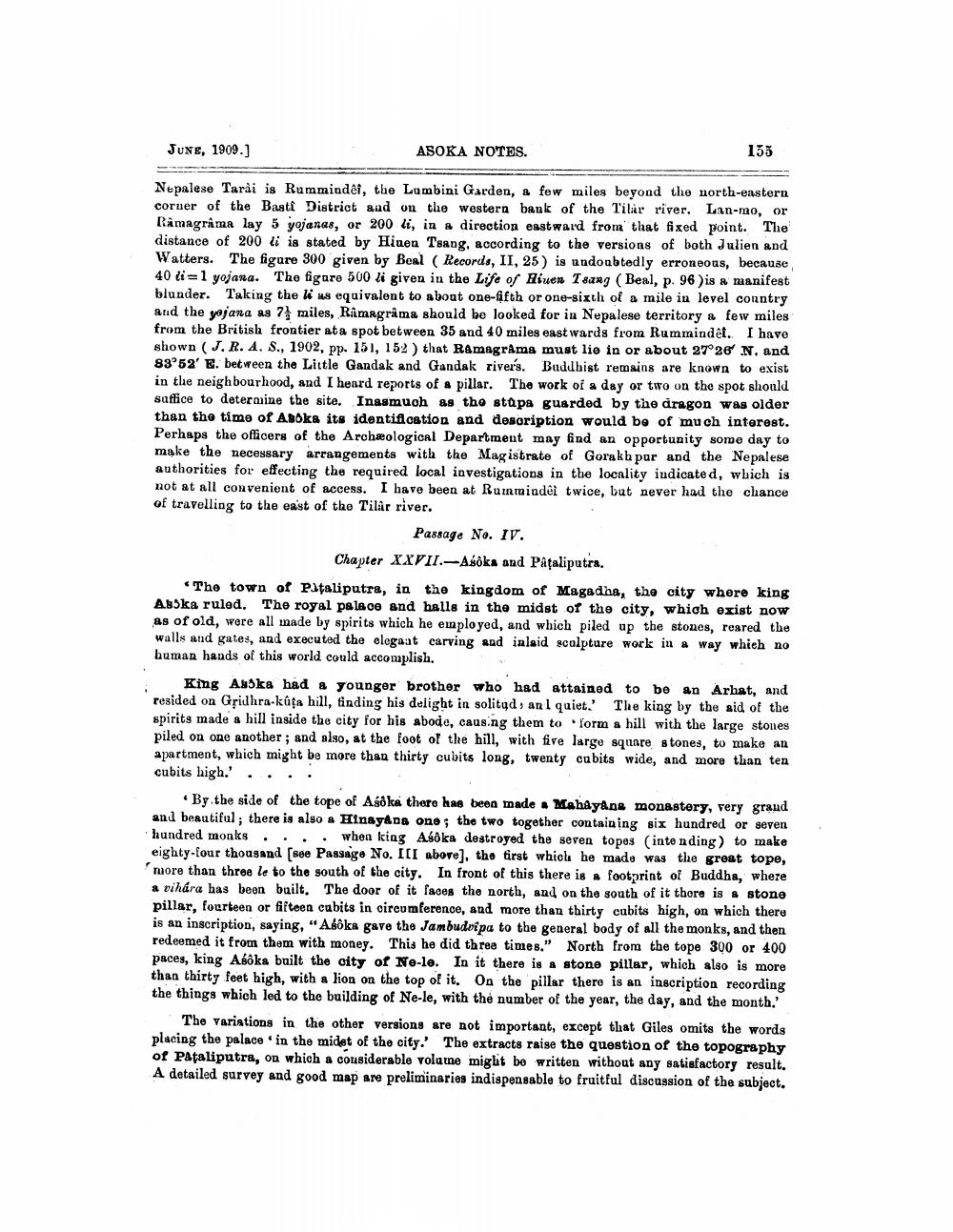________________
JUNE, 1909.)
ASOKA NOTES
155
Nepalese Tarki is Rummindei, the Lumbini Garden, a few miles beyond the north-eastern corner of the Basti District and on the western bank of the Tilar river. Lan-mo, or Råmagrâma lay 5 yojanas, or 200 li, in a direction eastward from that fixed point. The distance of 200 li is stated by Hinen Tsang, according to the versions of both Julien and Watters. The figure 300 given by Beal (Records, II, 25) is undoubtedly erroneous, because 40 di=1 yojana. The figure 500 li given in the Life of River Isang (Beal, p. 96 )is a manifest blunder. Taking the li us equivalent to about one-fifth or one-sixth of a mile in level conntry and the yojana as 7 miles, Rimagrama should be looked for in Nepalese territory a few miles from the British frontier ata spot between 35 and 40 miles eastwards from Rummindet. I have shown (J.R. A. S., 1902, pp. 151, 152 ) that Ramagrama must lio in or about 27° 26' N. and 83°52' E. between the Little Gandak and Gandak rivers. Buddbist remains are known to exist in the neighbourhood, and I heard reports of a pillar. The work of a day or two on the spot should suffice to determine the site. Inasmuch as the stapa guarded by the dragon was older than the time of Asoka its identification and desoription would be of much interest. Perhaps the officers of the Archeological Department may find an opportunity some day to make the necessary arrangements with the Magistrate of Gorakhpur and the Nepalese authorities for effecting the required local investigations in the locality indicated, which is not at all convenient of access. I have been at Rummiudet twice, but never had the chance of travelling to the east of the Tilår river.
Passage No. IV. Chapter XXVII.-Asöka and Påfaliputra.
The town of Pataliputra, in the kingdom of Magadha, the city where king AB5ka ruled. The royal palace and halls in the midst of the city, which exist now as of old, were all made by spirits which he employed, and which piled up the stones, roared the walls and gates, and executed the elegaat carving and inleid sculpture work in a way which no human hands of this world could accomplish.
King Aubka had a younger brother who had attained to be an Arbat, and resided on Gridhra-kûça hill, finding his delight in solitud, anl quiet.' The king by the aid of the spirits made a hill inside the city for his abode, causing them to form a hill with the large stones piled on one another; and also, at the foot of the hill, with five large square stones, to make an apartment, which might be more than thirty cubits long, twenty cubits wide, and more than ten cubits high.' . . . .
* By the side of the tope of Asoka there has been made . Mahayana monastery, very graud and beautiful; there is also a Hinayang one, the two together containing six hundred or seven hundred monks.... when king Asoka destroyed the seren topes (inte nding) to make eighty-four thousand (see Passage No. [[I above), the first which he made was the great tope, more than three le to the south of the city. In front of this there is a footprint of Buddha, where a vihára has been built. The door of it faces the north, and on the south of it there is a stone pillar, fourteen or fifteen cubits in circumference, and more than thirty cabits high, on which there is an inscription, saying, "Asöka gave the Jambudvípa to the general body of all the monks, and then redeemed it from them with money. This he did three times." North from the tope 300 or 400 paces, king Abôks built the city of No-le. In it there is a stone pillar, which also is more than thirty feet high, with a lion on the top of it. On the pillar there is an inscription recording the things which led to the building of Ne-le, with the number of the year, the day, and the month.'
The variations in the other versions are not important, except that Giles omits the words placing the palace in the midet of the city. The extracts raise the question of the topography of Pataliputra, on which a cousiderable volare might be written without any satisfactory result. A detailed survey and good map are preliminaries indispensable to fruitful discussion of the subject.




